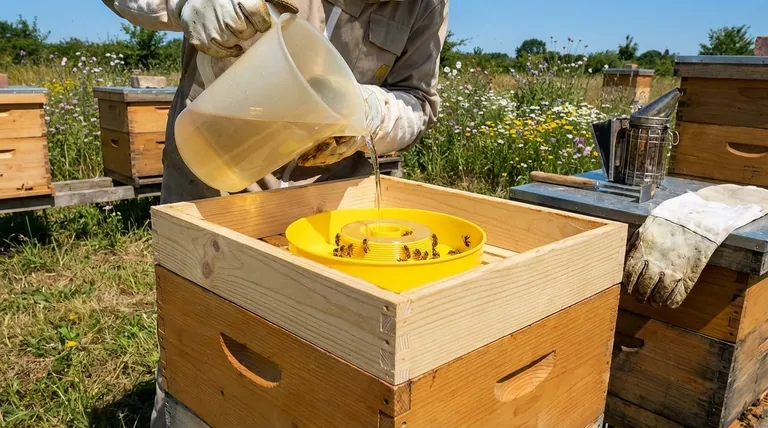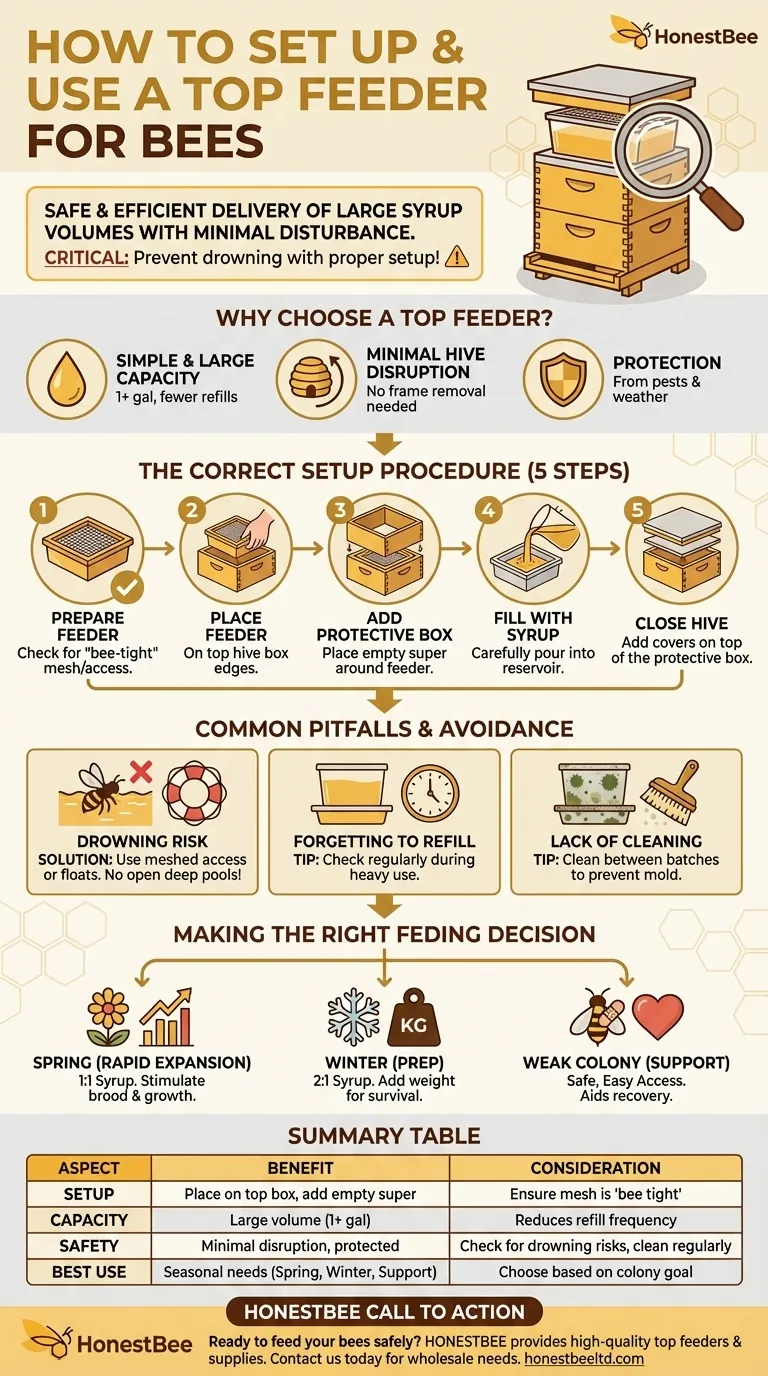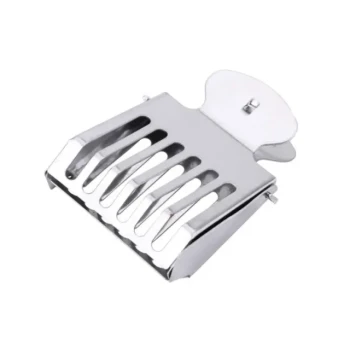To set up a top feeder for bees, place it directly on top of the uppermost hive box. You must then enclose it with an empty hive box for protection and to create a sealed feeding chamber. Before filling it with syrup, critically inspect the feeder to ensure any mesh or access points are secure to prevent bees from getting into the main reservoir and drowning.
Top feeders provide a safe and efficient method for delivering large volumes of syrup with minimal disturbance to the colony. However, their success is entirely dependent on a proper setup that prioritizes bee safety, particularly by preventing any chance of drowning.

Why Choose a Top Feeder?
Top feeders are a popular and effective tool for a reason. They offer significant advantages over other feeding methods by working in harmony with the bees' natural tendencies.
Simplicity and Large Capacity
Top feeders are exceptionally easy to use. They can be refilled quickly without fully dismantling the hive or disturbing the brood nest. Their large volume means you can provide a gallon or more of syrup at once, reducing the frequency of refills.
Minimal Hive Disruption
Because the feeder sits on top of the hive, refilling it only requires removing the outer and inner covers. This is far less intrusive than an internal frame feeder, which requires you to open the hive and remove frames.
Protection from Pests and Robbing
The syrup is completely enclosed within the hive structure, protected from rain, sun, and other environmental factors. More importantly, this design significantly reduces the risk of attracting pests or initiating robbing from other bee colonies.
The Correct Setup Procedure
A successful setup is about more than just placement. It's about creating a safe and effective feeding station for your colony.
Step 1: Prepare the Feeder
Before placing it on the hive, inspect your feeder. Ensure any hardware cloth or mesh screen covering the access area is "bee tight." There should be no gaps that would allow bees to get through to the main syrup reservoir from below.
Step 2: Place the Feeder on the Hive
Remove the telescoping top cover and the inner cover from your hive. Place the top feeder directly on the top edges of the uppermost hive box.
Step 3: Add a Protective Box
Place an empty hive body (a deep or medium super) around the top feeder. This empty box acts as a protective shield and creates the space for the bees to access the feeding area.
Step 4: Fill with Syrup
Carefully pour the sugar syrup into the reservoir section of the feeder. Avoid spilling syrup down the sides of the hive, as this can attract pests and encourage robbing.
Step 5: Close the Hive
Place your hive's inner cover and telescoping top cover directly on top of the empty box you added in Step 3. The hive is now sealed, and the bees can access the syrup from inside as needed.
Common Pitfalls and How to Avoid Them
While effective, top feeders have one critical risk that must be managed. Understanding this trade-off is key to using them successfully.
The Drowning Risk
The most significant danger of a top feeder is the potential for bees to drown. Some models have deep, open reservoirs that can be a death trap.
Always choose a feeder design that has a secure, meshed-off area for bee access or provides floats (such as wooden blocks or plastic floats) for the bees to stand on. Never give bees open access to a deep pool of syrup.
Forgetting to Refill
A large-capacity feeder can make it easy to forget to check syrup levels. During periods of heavy consumption, a colony can empty a gallon feeder in just a few days. Check the feeder regularly to ensure it doesn't run dry.
Lack of Cleaning
Syrup can ferment or grow mold over time. It's important to clean the feeder thoroughly between batches, especially during warmer weather, to ensure you are providing a healthy food source for your colony.
Making the Right Feeding Decision
Using a top feeder is a strategic decision that depends entirely on your colony's needs at a specific time of year.
- If your primary focus is rapid spring expansion: A top feeder is ideal for providing the high volume of 1:1 syrup needed to stimulate brood production and colony growth.
- If your primary focus is preparing for winter: Use a top feeder to quickly add weight to the hive with a thick 2:1 syrup, ensuring the colony has sufficient stores to survive.
- If your primary focus is saving a weak colony: A top feeder provides easy, safe access to food without forcing the bees to leave the hive, giving them the best chance for recovery.
Properly using a top feeder empowers you to support your colony's health and productivity through the seasons with confidence and control.
Summary Table:
| Key Aspect | Benefit | Consideration |
|---|---|---|
| Setup | Place on top box, add empty super | Ensure mesh is 'bee tight' to prevent drowning |
| Capacity | Large volume (1+ gallons) | Reduces refill frequency |
| Safety | Minimal hive disruption, pest protection | Must check for drowning risks and clean regularly |
| Best Use | Spring build-up, winter prep, weak colony support | Choose based on colony's seasonal needs |
Ready to feed your bees safely and efficiently?
As a trusted supplier for commercial apiaries and beekeeping equipment distributors, HONESTBEE provides high-quality top feeders and essential beekeeping supplies designed for durability and bee safety. Let us help you support your colony's health and productivity.
Contact HONESTBEE today to discuss your wholesale needs and get the right equipment for your operation.
Visual Guide

Related Products
- HONESTBEE Round Hive Top Bee Feeder for Syrup
- Professional Hive Top Bee Feeder for Beekeeping
- Rapid Bee Feeder White Plastic 2L Round Top Feeder for 8 or 10-Frame Bee Hives
- HONESTBEE Professional Hive Top Bee Feeder Feeding Solution
- HONESTBEE Entrance Bee Feeder Professional Hive Nutrition Solution for Beekeeping
People Also Ask
- What are the features of top feeders for bees? Maximize Hive Health with Safe, High-Capacity Feeding
- What is the correct method for preparing sugar syrup for bees? Ensure Safe, Non-Toxic Feeding for Your Hives
- How should syrup for bees be prepared? Master the Ratio for a Thriving Hive
- What safety features are included in top feeders? A Guide to Drowning Prevention and Hive Safety
- What types of hive boxes is the round hive top feeder compatible with? Universal Fit for 8 & 10-Frame Langstroth Hives



















